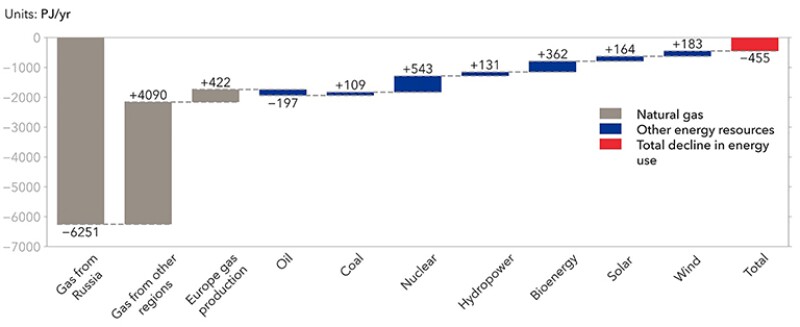As Europe struggles to balance energy security and energy independence following Russia’s invasion of Ukraine, uncertainty looms. By turning its back on Russian oil and gas, will Europe speed up or slow down its energy transition, and what will be the impact on the global climate change crisis? These are complicated questions that require a whole-system view and depend on the extent and duration of the war.
Energy Security
European policymakers are determined to slash the EU’s Russian gas dependence by two-thirds this year—a tall order. The replacement will be painful and costly, with increased LNG imports taking center stage.
Energy security ambition hinges on additional policies such as the International Energy Agency’s 10-point plan recommendations. Beyond nudging consumer behavior toward lower energy use, there is scope for a concerted policy push for energy efficiency, a postponement of nuclear retirements, and extensive renewable energy buildout.
Nonfossil supply and energy efficiency will accelerate; however, counterforces are at work: burning more coal to replace natural gas; and the increasing cost of electric vehicle (EV) batteries and solar photovoltaic (PV) panels through higher commodity prices. To this extent, the push for energy security works against the transition.
Modeling the Transition
DNV’s system dynamics energy transition model provides insight on how economics, technologies, sectors, geographies, and policies influence one another. The model assessed how the changes seen since 24 February 2022 could influence Europe’s energy transition.
Significant uncertainties fall from the war’s duration, possible escalation, and whether strengthened countermeasures completely stop the export of Russian oil and gas to the continent.
Europe’s Fit for 55 climate plan commitment will likely endure, though public reaction to energy affordability may challenge its momentum in the short term and other imponderables remain: Will a new cold war emerge or a calmer détente result? With these in mind, we modeled a scenario where Europe’s energy system discontinues Russian gas imports, with zero Russian gas from 2025 onward.
Higher Energy Prices
Russia produces approximately 17% of global natural gas and its exports met 33% of Europe’s consumption in 2020. When our model chokes Russian gas supply to Europe by 80% in 2023 and 100% in 2025, factoring in resulting higher gas prices, we see a spillover to other areas such as electricity prices. For 2024, the model sees an electricity price 12% higher than one with no change in Russian energy import. Globally, the war leads to 3% lower energy demand within 2 years, compared with a pre-war model, mainly because of lower gross domestic product (GDP).
Alternatives to Gas
We factored in gradual independence from Russian gas for the coming few years with exports to Europe dropping 40% on average for 2022, 80% in 2023, 90% in 2024, and 100% from 2025.
Within 2 years, Europe, including Norway and the UK, will increase domestic production with 420 petajoules (PJ), while imports, mainly Middle East and US LNG, will increase with 4,100 PJ—leaving a gas deficit or reduced consumption of 1,740 PJ (Fig. 1). Most will be replaced by other sources, but there will be some net reduction—decline in use—due to falling GDP, higher energy prices, and increased efficiency.

Ease and means of gas replacement depend on the sector. Growth and greening of electricity, bringing decarbonization of end uses in transport, building, and manufacturing, are the most important means to decarbonize European consumption. Renewables and nuclear have low operating costs and are at the top of a cost-merit order in our analysis, producing whatever quantities available. These will not in the short term cope with the gas shortfall; that is, when gas needs to be replaced by coal, which now costs more due to the war. The switch to coal is temporary. As the fuel of last resort, we find by 2024 only 6% of the reduction in natural gas supply will be taken up by coal.
Postponement of nuclear retirements and higher utilization of existing nuclear assets together produces an important short-term effect, and these developments are likely to happen in several countries, notably excluding Germany. Nuclear production makes up for one-third of the shortfall in natural gas.
Unlike most other energy sources, bioenergy costs have not grown due to the war, and it is possible to slightly grow bioenergy—mainly from sewage and waste—over the coming few years. We find that bioenergy makes up for 20% of the gap.
The contrasting main energy independence measure advanced by European politicians—a bigger, faster renewable energy buildout—has a much slower initial effect. It will take 2 years, for example, to make up 10% of the Russian gas import shortfall. While there may be a small impact in 2023, it becomes more meaningful each year. Over 5 years, the renewable buildout matches the 20% increase the EU aims for, and by 2030 solar PV and wind will account for more than 50% of the gas shortfall.
EV uptake will suffer from higher commodity prices inflating battery costs, delaying the milestone of 50% of new car sales in Europe by almost a year to 2028. This has further implications for long-term decarbonization and delays oil decline somewhat. Countries with ambitious 2030 decarbonization targets will need to review and possibly strengthen EV uptake incentives.
Looking at percentage changes, overall gas use is down 1,700 PJ, or 9%, in 2024 compared with our pre-war model run, while solar has the biggest percentage increase, up 9%. The overall effect on the energy mix is limited; Europe’s overall primary energy demand is 70 EJ (exajoules) or 70,000 PJ.
The decline in gas will see the decarbonization of the energy mix rise to 34% nonfossil energy sources in 2024, 2% higher than our pre-war model run, and that acceleration endures. By 2030, the overall change in nonfossil energy sources’ share continues to be 2% higher than pre‑war.
No energy has lower cost/footprint than that not used, and Europe is investing in energy efficiency to ensure energy independence. We expect demand in the building sector to decline a further 4% toward 2030, with efficient electricity use for heat pumps replacing some gas.
Energy-efficiency improvement is a key energy-consumption lever. European primary energy consumption peaked 15 years ago, and globally we expect primary energy demand to peak around 2030.
(Green) Hydrogen Push
Hydrogen is another important pillar in the independence and sustainability of Europe’s energy mix and its main challenge is affordability.
There are signals from Germany that the energy crisis is reducing opposition toward blue hydrogen. When Europe is in dire need of natural gas to replace Russian product, it is unlikely significant amounts of surplus will be available to produce blue hydrogen. Gas prices are high, making blue hydrogen less competitive through its additional carbon sequestration and storage costs. Even if blue remains cheaper than green hydrogen (produced from renewables by electrolysis) for the next few years, we find blue hydrogen uptake low in Europe toward 2030, decreasing rather than increasing because of the war.
Europe has limited capacity to produce sufficient renewable electricity to simultaneously phase out fossil fuels from the power mix and produce meaningful amounts of green hydrogen. Nevertheless, policymakers continue to prioritize both objectives. We anticipate higher support for green hydrogen amid the new push for renewables and factored a 12% lower hydrogen price into our model compared with our 2030 base case. Green hydrogen use in Europe will remain modest (roughly 0.4% of all energy use in Europe) by 2030, albeit that is 25% higher than the pre‑war model.
Gas Demand Shifts
Russia will look east to replace its energy export revenue but export capacity to China and neighbors is currently limited, while building new transmission pipelines and LNG export terminals takes significant time. Gas production in North East Eurasia, including Russia, Ukraine, and other former Soviet Union countries, will according to our model decline by 24% in 2024 through insufficient gas export infrastructure.
In contrast, we estimate Europe will produce 12% more gas between now and 2030, reflecting short-term industry reaction to higher oil and gas prices and responses to the pledge from the EU to deliver more gas. We anticipate that overinvestments will see lower oil and gas prices after 2025, and our model suggests this will lead to a small increase in global oil use later in the 2030s relative to our pre-war forecast.
A Small Acceleration of Decarbonization and Emission Reduction
Reducing greenhouse gas emissions is the global goal, and though the invasion in Ukraine will prompt a small acceleration of decarbonization and emissions reduction toward 2030, the main short-term influence is postponed nuclear retirements. Medium term, a faster renewables buildout, increased energy efficiency, and lower economic growth are key. The overall effect is, however, limited to a 580 Mt, or 2.3%, fall in emissions in Europe from 2022 to 2030 compared to a case without the Ukraine conflict.
Reduced gas consumption is the largest total-emissions-change influence, while the changes in other energy sources and carbon capture and storage (CCS) are minor in comparison (Fig. 2).

We forecast a small acceleration of the energy transition in Europe as the most likely energy-related outcome of the Ukraine war. As with COVID-19, we see Europe manage to cope with the short-term without harming its ability to deal with the long-term climate crisis.
At a global level, the net effect of the war on the energy transition is minor. The DNV system dynamics model captures some of the emerging global complexities, including changes in energy trade and the effect of increased commodity prices.
Our Energy Transition Outlook 2022, to be published toward the end of this year, will analyze these developments more fully. At this point, we conclude that improved energy security does not come at the cost of decarbonization and there is likely to be a small acceleration in Europe’s energy transition. The Energy Transition Outlook 2021 is available here.

Hari Vamadevan is senior vice president, DNV–Energy Systems. He has 30 years’ experience in leadership positions and leads a 700-strong team helping customers make the transition to a decarbonized energy future. Vamadevan is currently head of the Energy Systems operations in the UK and Ireland and is also chairperson of all DNV’s UK entities. He is an authority on the complex facets of the whole-systems approach to the energy transition. In his previous position he was managing director of Jardine Consulting Group which was acquired by DNV in 2005. During his time with Jardine, he was involved in performance studies for numerous companies listed on Fortune 500 and since joining DNV he has held senior management roles in the maritime, oil and gas, and more recently, the combined oil and gas and alternative energy businesses. Vamadevan holds a master’s degree in chemical engineering from Imperial College, London.

